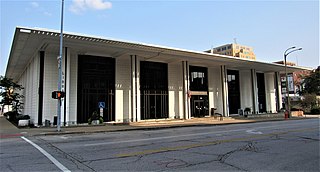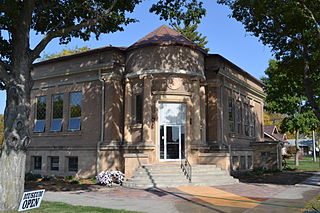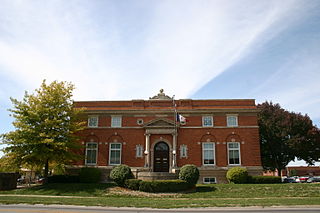
Illinois Carnegie Libraries Multiple Property Submission was a National Register of Historic Places Multiple Property Submission in the U.S. state of Illinois, approved on February 16, 1994. The submission included a group of sixteen Illinois libraries whose construction was funded by early 20th century philanthropist Andrew Carnegie. The sixteen libraries were all added to the National Register of Historic Places between 1978 and 2002.

The Davenport Public Library is a public library located in Davenport, Iowa. With a history dating back to 1839, the Davenport Public Library's Main Library is currently housed in a 1960s building designed by Kennedy Center architect Edward Durell Stone. The Davenport Public Library system is made up of three libraries—the Main Library at 321 Main Street; the Fairmount Branch Library at 3000 N. Fairmount Street; and the Eastern Avenue Branch Library at 6000 Eastern Avenue.

The Council Bluffs Public Library serves the residents of Council Bluffs, Iowa, United States along with unincorporated and rural areas of Pottawattamie County. Several cities also contract with the library to provide services. It dates back to 1866. The library is currently located on Willow Avenue. The previous library building on Pearl Street was listed on the National Register of Historic Places in 1999.

Ottumwa Public Library is a public library located in downtown Ottumwa, Iowa, United States. The current building was built in 1901. It is part of the Central Park area, which is the civic center of the community. It includes the Wapello County Courthouse, Ottumwa City Hall, and St. Mary of the Visitation Catholic Church. The library was listed on the National Register of Historic Places in 1984.

The Perry Carnegie Library Building, also known as the Carnegie Library Museum, is a historic structure located in Perry, Iowa, United States. The Perry Library Association was established in 1894, and William Tarr served as its first librarian. Andrew Carnegie accepted Perry's application for a grant for $10,600 on January 13, 1903. The Des Moines architectural firm of Liebbe, Nourse & Rasmussen designed the Neoclassical building that was built by local contractor Courtney and Bolt. It opened in September 1904 was dedicated on December 10.

Alden Public Library is located in Alden, Iowa, United States. The community's first library association was formed in 1882, and they acquired 225 books. The annual membership fee to use the library was $1. It was discontinued within two years, and Alden's second library association was formed in 1885 by women in the community. In time they were able to build their own building in 1892 and convince the city government to take over its support. Shortly after the city took over they contacted the Carnegie Foundation, who funded the construction of a new building with a $9,000 grant. It was designed by the Des Moines architectural firm of Wetherell & Gage, and shows Beaux Arts styling. The new building was dedicated on August 26, 1914. It is believed to be one of the smallest Carnegie libraries ever built. The building was listed on the National Register of Historic Places in 1981.

The Cherokee Public Library is located in Cherokee, Iowa, United States. A library was begun in town in 1886 by the Cherokee Ladies Library Association. The collection of books was housed in the YMCA and other shared facilities. It was poorly funded, and the city of Cherokee took over the library in 1898 after voters passed a referendum. The Carnegie Corporation of New York had accepted the city's application for a grant for $10,000 on January 6, 1903. They hired Oskaloosa, Iowa architect Frank E. Wetherell to design the new building, which was built by Hansen and Lambkin of New Hampton, Iowa. Carnegie donated a further $2,000 to complete construction. It was dedicated on May 2, 1905.

Emmetsburg Public Library was at a historic building located in Emmetsburg, Iowa, United States. A former Carnegie library, it sits on the square behind the Palo Alto County Courthouse. Andrew Carnegie had accepted Emmetsburg's application for a grant for $10,000 on February 20, 1911. The building is significant for its architecture. It was designed by Bloomington, Illinois architect A.T. Simmons and completed in 1912. The brick, side gable structure has a projecting entrance on the long side of the building. A string course encircles the building, engaging the lintels of the windows. The building was listed on the National Register of Historic Places in 1983.

The Eagle Grove Public Library, now the Eagle Grove Historical Museum, is a historical building in Eagle Grove, Iowa, United States. A subscription library was begun in Eagle Grove around 1885, and housed in the post office. The impetus for the first free public library was a 1901 advertising campaign by a Des Moines insurance and investment company. When local citizens bought company's bonds, the company donated 250 books to the town. The books were housed in the Masonic Hall. The Carnegie Corporation of New York accepted Eagle Grove's application for a grant for $10,000 to build a library building on April 26, 1902. It was designed by the Des Moines architectural firm Smith & Gage in the Beaux Arts style. The library was dedicated on September 15, 1903. It is a brick structure with a conical-roofed entrance pavilion. Four engaged columns in the Ionic order flank the main entryway. The public library has subsequently moved to a larger facility, and the old library building was turned over to the local historical society for a museum. The building was listed on the National Register of Historic Places in 1983.

Bloomfield Public Library is a public library located in Bloomfield, Iowa, United States. A library in Bloomfield dates back to the 1870s when a library association was established. One had to pay a subscription fee in order to borrow books. The Carnegie Corporation of New York had accepted the Commercial Club of Bloomfield's application for a grant for $10,000 on November 21, 1911. An election on December 30, 1911 approved constructing new public library in town. The building was designed by Frank E. Wetherell of the Des Moines architectural firm of Wetherall and Gage, and contractor C.W. Ennis constructed it. The new library was dedicated on August 8, 1913. The library is a brick, side gable structure with a projecting entrance on the long side of the building. Both the entrance and the side elevations of the building feature Tudor Revival vergeboards and half-timbered gable ends. The collection includes books in large print, regular print, hard back books and paperbacks, movies, and books-on-CD. Other services include public computers, a young adult section, and a children's area. The building was listed on the National Register of Historic Places in 2015.

Oskaloosa Public Library is a facility located in Oskaloosa, Iowa, United States. Construction of the library was launched in 1902 with a grant from the Carnegie Corporation of New York. The building was added to the National Register of Historic Places in 1991.

The Architecture of Henry K. Holsman Historic Campus District, also known as the Maharishi International University, is a nationally recognized historic district located in Fairfield, Iowa, United States. It was listed on the National Register of Historic Places in 1983. At the time of its nomination it included five contributing buildings that were built from 1903 to 1915 on the campus of Parsons College. They were designed in the Collegiate Gothic style by Iowa-born and Chicago-based architect Henry K. Holsman. It also includes Ewing Hall, which is an older building on the campus, and individually listed on the National Register. The buildings were built after the destruction by fire of Ankeny Hall in 1902. Foster Hall (1903), Fairfield Hall (1903), and the Carnegie Library (1907) have elements of the Beaux-Arts style. Barhydt Chapel and the Parsons Bible School were completed in 1912. Parsons Hall was completed in 1915.

The former Spirit Lake Public Library is located in downtown Spirit Lake, Iowa, United States. The Civic Improvement Association started a library in a rented commercial building downtown in 1901. The initial collections were acquired through Iowa's traveling library system. A referendum to support a public library was passed in 1904, which made a grant from the Carnegie Corporation of New York possible. Spirit Lake's application was accepted for a grant for $8,000 on February 1, 1905. The search for a lot for the building delayed construction. The library was dedicated on September 24, 1912. The single-story brick structure was built on a raised basement, and features vaguely Tudor Revival elements. The center frontispiece and the tall windows give it a sense of verticality. The building was listed on the National Register of Historic Places in 1980. The public library has subsequently been relocated into a new building, and the historic building has been converted into commercial space.

Chariton Public Library is located in Chariton, Iowa, United States. The Library and Reading Room Association was formed in Chariton in 1879, but it was short-lived. The county superintendent of schools started a teachers' library in the courthouse sometime afterward. By this time the community had a library of 800 volumes. There was an effort by study clubs in town in 1898 to raise money and establish a free public library. The Chariton Federation of Women's Clubs took the lead and opened a library with the books from the courthouse in two rooms above Gibbons Drug Store on the town square. Citizens approved a local tax to support the library the following year.

Onawa Public Library is located in Onawa, Iowa, United States. The public library began in 1902 when Judge Addison Oliver offered to buy the former Congregational Church for a library building, and funds to buy books and fixtures. His offer was accepted by the community, which also promised to maintain the facility as a free library. The library soon outgrew the old church and in November 1906 the board of directors approached the Carnegie Corporation of New York for a grant to build a library building. A $10,000 grant was approved on December 13, 1907. Judge Oliver donated another $10,000 for the building, and an additional $10,000 for an endowment fund. The Chicago architectural firm of Patton & Miller designed the Prairie School building, which was dedicated on October 22, 1909. It was listed on the National Register of Historic Places in 1979.

The Waterloo Public Library is a historic building located in Waterloo, Iowa, United States. The public library was established there in 1896. It operated out of two rented rooms, one on the east side of the Cedar River and other on the west side. The Carnegie Foundation agreed to grant the community $21,000 to build this building and a similar amount for the east side branch on April 11, 1902. Waterloo architect J.G. Ralston designed both buildings in the Neoclassical style. They were both dedicated on February 23, 1906. The single-story brick structure has a projecting entrance pavilion capped with a triangular pediment that is supported by Ionic columns. Also noteworthy are the corner piers that feature bands of brick squares set into the stone. In 1977 voters in Waterloo approved a $3,650,000 bond referendum to renovate the city's 1938 post office and federal building to house the library. The post office vacated the building in 1979 when it relocated. The old library building was listed on the National Register of Historic Places in 1983. It now houses law offices.

The Waterloo Public Library-East Side Branch is a historic building located in Waterloo, Iowa, United States. The public library was established here in 1896. It operated out of two rented rooms, one on the east side of the Cedar River and other on the west side. The Carnegie Foundation offered a grant of $30,000 to build a new library, but disagreements erupted over whether to place the building on the east side or west side of the river. They then agreed to grant $40,000 for a mid-river building, or the same amount for two buildings. In the end they agreed to grant the community $24,000 to build this building and a similar amount for the west side branch. Waterloo architect John G. Ralston designed both buildings in the Neoclassical style. Both were dedicated on February 23, 1906. The single-story Bedford stone structure was built over a raised basement. It is one of the few stone buildings in Waterloo. The building has a central portico with paired Ionic columns. It is part of a larger central mass that is oriented from front to back and sits across the lower hipped roof.

The Mason City Public Library is located in Mason City, Iowa, United States. The building that was funded by Andrew Carnegie, and is now an office building, was listed on the National Register of Historic Places in 1989. It was included as a contributing property in the Mason City Downtown Historic District in 2005.

The Sioux City Free Public Library is a historic building located in Sioux City, Iowa, United States. The library was located in a section of the Municipal Building, no longer extant, between 1892 and 1913. It had outgrown the space when the Library Board contacted Andrew Carnegie in 1910 about providing the funding for a new library building. Their request was initially turned down. They chose to work with New York City architect Edward L. Tilton, an architect preferred by Carnegie, in place of local architect William L. Steele who was working with the board previously. Local resident George Murphy donated the property for the new building. Meanwhile, Tilton designed the two-story brick Renaissance Revival building. On April 8, 1911, Carnegie approved the project and donated $75,000 for the building's construction. The new building was dedicated on March 6, 1913, and it is considered "an excellent early twentieth century example of the architectural development of library planning and design." It was Tilton's only building in Iowa.

The Carnegie-Stout Public Library is located in Dubuque, Iowa, United States. The public library had its beginnings with the Young Men's Literary Association, established in 1859, and their book collection was the basis for the library's collection. The books were housed in a variety of buildings over the years. The community applied for a grant from Andrew Carnegie who on January 12, 1901 contributed $71,500 to build the library building. Local businessman Frank D. Stout donated the property, which was worth $20,000, in honor of his father Henry L. Stout. The two-story Bedford stone and brick building was designed by Chicago architects W. G. Williamson and John Spencer. It is considered one of the finest examples of the Classical tradition of Beaux-Arts architecture in Iowa. The main facade is dominated by a Roman Corinthian portico that was modeled after the Pantheon in Rome. Its fluted columns are matched with pilasters on the wall behind. The building was dedicated on October 17, 1902, and it opened three days later. It was individually listed on the National Register of Historic Places in 1975, and it was included as a contributing property in the Jackson Park Historic District in 1986. An addition was added to the east side of the building in 1981.






















